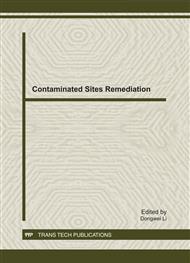[1]
Luo Guyuan, Wu Song, Xiao Hua, etal. Analysis of Cyperus alternifolius foam floating islands on nitrogen removal in polluted rivers[J]. Journal of Chongqing University., 31(10) (2008) 1169~1173.
Google Scholar
[2]
Tie Baiqing, Li Xi, Li Jiefeng, etal. Comparison of removal effect of three plants artificial floating islands for water purification under dynamic conditions[J]. Chinese Journal of Environmental Engineering, 4(7) (2010) 1566~1571.
Google Scholar
[3]
Lu Jindeng, Chen Hongbing , Zhao Liya, etal. Study on the growth characteristics of seven plants cultivated on artificial floating rafts in eutrophic water[J]. Techniques and Equipment for Environmental Pollution Control, 7(7) (2006) 58~61.
Google Scholar
[4]
Zou Ran, Zhang Menglu, Zhao Haoxuan, etal. Research on Water Quality Restoration by Cultivating Some Valuable Flowers in Multifunctional Floating Bed[J]. Journal of Wuhan University of Science and Engineering, 23(4) (2010) 57~60.
Google Scholar
[5]
Tang Linsen, Chen Jin, Huang Zhou. The Development of Artificial Floating-Island[J]. Journal of Yangtze River Scientific Research Institute, 25(1) (2008) 21~25.
Google Scholar
[6]
Sun Jian, Tie Boqing, Qian Zhan, etal. Effects of Cu, Cd, Pb, Zn and As Single Stress on the Hrowth and Physiological and Biochemical Characteristics of Juncus Effuses[J]. Chinese Journal of Soil Science, 38(1) (2007)121~127.
Google Scholar
[7]
Zhang Zhiliang, Que Weipu. Phytophysiology Experiment Instruction(The third edition) [M]. Higher Education Press, (2007).
Google Scholar
[8]
Huang Yongjie, Yang Jihui, Yang Hongfei, etal. Effects of Zn on the Growth and Scavenging System of Activated Oxygen of Alternanthera philoxeroid[J]. Chinese Agricultural Science Bulletin, 25(05) (2009) 160-164.
Google Scholar
[9]
Zhou Qing, Huang Xiaohua, Shi Guoxin. Effect of Cadmium on the Physiological and Biochemical Character of Evergreen Trees[J]. Research of Environmental Sciences, 14(3) (2001) 9~11.
Google Scholar
[10]
Li Jianhong, Tai Zihou, Li Jianhong. Mechanism of Cu2+ Inhibiting Photosynthesis of Spirulina maxima. Acta Photophysiologica sinica, 23(1) (1997) 77~82.
Google Scholar
[11]
Yin Yongqiang, Hu Jianbin, Deng Mingjun. Latest Development of Antioxidant System and Responses to Stress in Plant Leaves[J]. Chinese Agricultural Science Bulletin, 23(1) (2007)105~107.
Google Scholar
[12]
Wang Xue. Effects of Spermine on Antioxidant Enzyme Systems and Membrane Lipid Peroxidation in Cucumber Seedling under Low Temperature Stress[J]. Seed, 27(11) (2008) 33~36.
Google Scholar
[13]
Zhao Yanhong, Yuan Xiaoying, Guo Dongsheng. Effect of Cu2+ and Cd2+ on Activity and Fluorescence Spectrum of Catalase[J]. Journal of Agro-environmental Science, 23(6) (2004)1086~1088.
Google Scholar
[14]
Tang Junmei. Study on the Physiological and Biochemical Response and Differentially Expressed Proteome under Cold Stress in Buffalograss[D]. Chinese Academy of Agricultural sciences, (2008).
Google Scholar
[15]
Zhang Yuxiu, Chai Tuanyao, Gerard Burkard. Research Advances on the Mechanisms of Heavy Metal Tolerance in Plants[J]. Acta Photophysiologica sinica, 41(5) (1999) 453~457.
Google Scholar
[16]
Zhu Tao, Yang Meiying. Effect of Low Temperature Treatment on Protective Enzyme Activity of Different Varieties Rice Seedlings. Jilin Agricuture, (2010)7: 89.
Google Scholar
[17]
Ye Yaxin, Jin Jin, Qin Fenju, etal. Effects of Low Temperature Stress on Superoxide Dismutase Activity of Wheat, Corn, Radish Seedlings[J]. Chinese Agricultural Science Bulletin, 25(23) (2009) 244~248.
Google Scholar
[18]
Zhang Gexiang. Effect of Low-temperature Stress on Physiological Reaction of Cineraria[J]. Journal of Nanjing Forestry University, 28(5) (2004) 89~92.
Google Scholar
[19]
Ye Xiaoqing, Wang Songfeng, Tang Risheng, etal. Effect of Low Temperature Stress on Physiological and Biochemical Characteristics of Hongfenjiaren[J]. Jiangsu Journal of Agricultural Sciences, 24(5) (2008) 612~61.
Google Scholar
[20]
Chen XuWei, Yang Ling, Zhang Yi, etal. Effects of Low Temperature at 10℃ on Some Antioxidant Enzyme Activities and Ultrastructures of Hypocotylar Cells in Mung Bean and Garden Pea[J]. Acta Photophysiologica Sinica, 31(5) (2005) 539~544.
Google Scholar
[21]
Han Chunmei. Effects of Copper Stress on Physiological and Biochemical Indexes of Radish Seedlings Roots. Jiangsu Agricultural Sciences, (1) (2010) 179~180.
Google Scholar
[22]
Wang Xiaolan, Zhou Shoubiao, Yang Jihui, etal. Copper Stress on the Growth and Some Physiological Parameters of Carex dispalata[J]. Journal of Agro-Environment Science, 29(2) (2010) 264~269.
Google Scholar
[23]
Liu Huiying, Zhu Zhujun, Lu Guohua . Effect of low temperature stress on chilling tolerance and protective system against active oxygen of grafted watermelon[J]. Chinese Journal of Applied Ecology, 15(4) (2004) 659~662.
Google Scholar
[24]
Nan Ming, Wang Hanning, Zhang Jinwen, etal Effects of low-temperature on physiological and biochemical indexes in different grain types of maize seeds[J]. Journal of Gansu Agricultural University, 45(6) (2010) 71~74.
Google Scholar
[25]
Peng Hongli, Su Zhixian. Effect of Low Temperature Stress on the Activity of Perox Dase, the Content of Chlorophyll and Free Proline in Davidia involucrata Seedling[J]. Journal of Hanzhong Teachers College, 22(2) (2004) 50~53.
Google Scholar
[26]
Jin Song, Wu Ke, Yu Zhimin, etal. Physiological response of Imperata cylindrica var. majo seedlings on growth and antioxidant enzyme system under Cu stress[J]. Journal of Biology, 27(4) (2010) 22-23.
Google Scholar
[27]
Zhen Quan, Yan Mi, Yang Hongfei, etal. Coercion and damage of Cu pollution on Artemisia lavandulaefolia growth[J]. Chinese Journal of Applied Ecology, 17(8) (2006) 1505~1510.
Google Scholar
[28]
Li Jun, Zhou Shoubiao, Huang Wenjiang, etal. Cu and Pb contents in Dichondra repens leaf and their effects on its physiological indexes[J]. Chinese Journal of Applied Ecology, 15(12) (2004) 2355~2358.
Google Scholar


